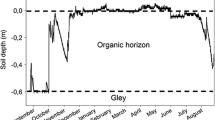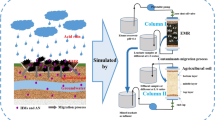Abstract
In the summertime, the manganese pollution in moderately deep lakes and reservoirs caused by thermal stratification processes has been a serious problem. To mitigate the issue, understanding the key factors that control manganese releases from reservoir soils is a critical step. To this end, batch experiments and the response surface methodology (RSM) analysis were conducted in this study to investigate the release of Mndiss and Mn(III) (0.45 μm filterable) from soil samples collected along a reservoir shore under different combined effects of pH, dissolved oxygen (DO), temperature, and dissolved organic carbon (DOC). According to the three-dimensional (3-D) response surfaces plotted from the mathematical model, the highest concentrations of Mndiss and Mn(III) released from the studied soils were achieved when the release process was carried out at 30.0 °C using a citric acid solution (10.8 mg/L) of pH 6.0 with the DO concentration of 0.0 mg/L. It was found that pH was the most significant factor affecting the release of Mndiss and Mn(III) among the four factors. The combined effect of pH and DOC was also very significant to stimulate Mn(III) releases. In addition, both Mndiss and Mn(III) followed the same release principle under the coupled effects of the four factors. A close agreement between experimental and predicted values from the developed models was found.




Similar content being viewed by others
References
Amini M, Younesi H, Bahramifar N (2009) Biosorption of nickel(II) from aqueous solution by Aspergillus niger: response surface methodology and isotherm study. Chemosphere 75:1483–1491
Beck M, Dellwig O, Schnetger B, Brumsack H-J (2008) Cycling of trace metals (Mn, Fe, Mo, U, V, Cr) in deep pore waters of intertidal flat sediments. Geochim Cosmochim Acta 72:2822–2840
Beutel MW, Leonard TM, Dent SR, Moore BC (2008) Effects of aerobic and anaerobic conditions on P, N, Fe, Mn, and Hg accumulation in waters overlaying profundal sediments of an oligo-mesotrophic lake. Water Res 42:1953–1962
Bouchard MF, Sauvé S, Barbeau B, Legrand M, Brodeur M, Bouffard T, Limoges E, Bellinger DC, Mergler D (2011) Intellectual impairment in school-age children exposed to manganese from drinking water. Environ Health Perspect 119:138–143
Box GEP, Behnken DW (1960) Some new three level designs for the study of quantitative variables. Technometrics 2:455–475
Brandenberger J, Louchouarn P, Herbert B, Tissot P (2004) Geochemical and hydrodynamic controls on arsenic and trace metal cycling in a seasonally stratified US sub-tropical reservoir. Appl Geochem 19:1601–1623
Bryant LD, Hsu-Kim H, Gantzer PA, Little JC (2011) Solving the problem at the source: controlling Mn release at the sediment-water interface via hypolimnetic oxygenation. Water Res 45:6381–6392
Butler BA (2009) Effect of pH, ionic strength, dissolved organic carbon, time, and particle size on metals release from mine drainage impacted streambed sediments. Water Res 43:1392–1402
Canfield DE, Thamdrup B, Kristensen E (2005) Advances in marine biology. Elsevier, London
Cao X, Chen Y, Wang X, Deng X (2001) Effect of redox potential and pH value on the release of rare earth elements from soil. Chemosphere 44:655–661
Cheng R, Li G, Cheng C, Liu P, Shi L, Ma Z, Zheng X (2014) Removal of bacteriophage f2 in water by nanoscale zero-valent iron and parameters optimization using response surface methodology. Chem Eng J 252:150–158
Corsini A, Cavalca L, Zaccheo P, Crippa L, Andreoni V (2011) Influence of microorganisms on arsenic mobilization and speciation in a submerged contaminated soil: effects of citrate. Appl Soil Ecol 49:99–106
Duckworth OW, Sposito G (2005) Siderophore–manganese(III) interactions. I. Air-oxidation of manganese (II) promoted by desferrioxamine B. Environ Sci Technol 39:6037–6044
Elksibi I, Haddar W, Ticha MB, Gharbi R, Mhenni MF (2014) Development and optimisation of a non conventional extraction process of natural dye from olive solid waste using response surface methodology (RSM). Food Chem 161:345–352
Ferreira SLC, Bruns RE, Ferreira HS et al (2007) Box-Behnken design: an alternative for the optimization of analytical methods. Anal Chim Acta 597:179–186
Finley JW, Davis CD (1999) Manganese deficiency and toxicity: are high or low dietary amounts of manganese cause for concern? Biofactors 10:15–24
Gan YJ, Duan QY, Gong W, Tong C, Sun YW, Chu W, Ye AZ, Miao CY, Di ZH (2014) A comprehensive evaluation of various sensitivity analysis method s: a case study with a hydrologica model. Environ Model Softw 51:269–285
Gerringa LJA (1990) Aerobic degradation of organic matter and the mobility of Cu, Cd, Ni, Pb, Zn, Fe and Mn in Marine Sediment Slurries. Mar Chem 29:355–374
Gordienko VI, Sidorenko VI, Mikhailyuk YI (1970) Amperometric investigation of Mn (III) pyrophosphate complexes. Russ J Inorg Chem 15:1241
Gottfreund J, Schmitt G, Schweisfurth R (1985) Wertigkeitswechsel von Manganspecies durch Bakterien in Nahrlosungen and in Lockergestein. Landwirtsch Forsch 38:80–86
Graham MC, Gavin KG, Farmer JG, Kirika A, Britton A (2002) Processes controlling the retention and release of manganese in the organic-rich catchment of Loch Bradan, SW Scotland. Appl Geochem 17:1061–1067
Hamilton-Taylor J, Smith EJ, Davison W, Sugiyama M (2005) Resolving and modeling the effects of Fe and Mn redox cycling on trace metal behavior in a seasonally anoxic lake. Geochim Cosmochim Acta 69:1947–1960
Heintze SG, Mann PJG (1947) Soluble complexes of manganic manganese. J Agric Sci 37:23
Huang SS, Wan ZH, Zhang CY (1994) Effect of grain size of sediment on the adsorption of heavy metals. J Hydraul Eng 10:53–60 (in Chinese)
Huang Y, Yuan Y, Zhou Z, Liang J, Chen Z, Li G (2014) Optimization and evaluation of chelerythrine nanoparticles composed of magnetic multiwalled carbon nanotubes by response surface methodology. Appl Surf Sci 292:378–386
İbanoglu Ş, Ainsworth P (2004) Effect of canning on the starch gelatinization and protein in vitro digestibility of tarhana, a wheat flour-based mixture. J Food Eng 64:243–247
Junta JL, Hochella MF Jr (1994) Manganese (II) oxidation at mineral surfaces: a microscopic and spectroscopic study. Geochim Cosmochim Acta 58:4985–4999
Klewicki JK, Morgan JJ (1998) Kinetic behavior of Mn (III) complexes of pyrophosphate, EDTA, and citrate. Environ Sci Technol 32:2916–2922
Koretsky CM, Haas JR, Miller D, Ndenga NT (2006) Seasonal variations in pore water and sediment geochemistry of littoral lake sediments (Asylum Lake, MI, USA). Geochem Trans 7:11
Kostka JE, Luther GW III, Nealson KH (1995) Chemical and biological reduction of Mn (III)-pyrophosphate complexes: potential importance of dissolved Mn (III) as an environmental oxidant. Geochim Cosmochim Acta 59:885–894
Krivtsov V, Sigee DC (2005) Importance of biological and abiotic factors for geochemical cycling in a freshwater eutrophic lake. Biogeochemistry 74:205–230
Kumar J, Bansal A (2013) Photocatalytic degradation in annular reactor: modelization and optimization using computational fluid dynamics (CFD) and response surface methodology (RSM). J Environ Chem Eng 1:398–405
Li Y, Wang X, Guo S, Dong D (2006) Cu and Zn adsorption onto non-residual and residual components in the natural surface coatings samples (NSCSs) in the Songhua River, China. Environ Pollut 143:221–227
Lin R, Li H, Long H, Su J, Huang W, Wang S (2014) Optimization of lipase-catalyzed rosin acid starch synthesis by response surface methodology. J Mol Catal B Enzym 105:104–110
Lorenz C, Merten D, Haferburg G, Kothe E, Büchel G (2012) Geomicrobial manganese redox reactions in metal-contaminated soil substrates. In: Erika K, Ajit V (eds) Bio-geo interactions in metal-contaminated soils. Springer, Berlin, pp 99–112
Lors C, Tiffreau C, Laboudigue A (2004) Effects of bacterial activities on the release of heavy metals from contaminated dredged sediments. Chemosphere 56:619–630
Mohan D, Chander S (2006) Single, binary, and multicomponent sorption of iron and manganese on lignite. J Colloid Interface Sci 299:76–87
Mondal P, Majumder CB, Mohanty B (2008) Effects of adsorbent dose, its particle size and initial arsenic concentration on the removal of arsenic, iron and manganese from simulated ground water by Fe3+ impregnated activated carbon. J Hazard Mater 150:695–702
Montgomery DC (2008) Design and analysis of experiments, 7th edn. Wiley, New York, 2008
New York State Department of Environmental Conservation (NYSDEC) (1999) Technical guidance for screening contaminated sediments. New York Division of Fish, Wildlife and Marine Resources, Albany
Pakhomova S, Yakushev EV (2011) Manganese and iron at the redox interfaces in the Black Sea, the Baltic Sea, and the Oslo Fjord. In: Yakushev EV (ed) Chemical structure of pelagic redox interfaces. Springer, Berlin, pp 67–93
Perez J, Jeffries TW (1992) Roles of manganese and organic acid chelators in regulating lignin degradation and biosynthesis of peroxidases by Phanerochaete chrysosporium. Appl Environ Microbiol 58:2401–2409
Rodrigues RCLB, Kenealy WR, Dietrich D, Jeffries TW (2012) Response surface methodology (RSM) to evaluate moisture effects on corn stover in recovering xylose by DEO hydrolysis. Bioresour Technol 108:134–139
Rout SK, Choudhury BK, Sahoo RK, Sarangi SK (2014) Multi-objective parametric optimization of Inertance type pulse tube refrigerator using response surface methodology and non-dominated sorting genetic algorithm. Cryogenics 62:71–83
Şahan T, Ceylan H, Şahiner N, Aktaş N (2010) Optimization of removal conditions of copper ions from aqueous solutions by Trametes versicolor. Bioresour Technol 101:4520–4526
Schlosser D, Höfer C (2002) Laccase-catalyzed oxidation of Mn2+ in the presence of natural Mn3+ chelators as a novel source of extracellular H2O2 production and its impact on manganese peroxidase. Appl Environ Microbiol 68:3514–3521
Sharma SK, Kappelhof J, Groenendijk M, Schippers JC (2001) Comparison of physicochemical iron removal mechanisms in filters. J Water Supply Res Technol 50:187–198
Sun L, Zhang CL (2014) Evaluation of elliptical finned-tube heat exchanger performance using CFD and response surface methodology. Int J Therm Sci 75:45–53
Sundby B, Anderson LG, Hall POJ, Iverfeldt Å, Vanderloeff MMR, Westerlund SFG (1986) The effect of oxygen on release and uptake of cobalt, manganese, iron and phosphate at the sediment-water interface. Geochim Cosmochim Acta 50:1281–1288
Tebo BM, Johnson HA, McCarthy JK, Templeton AS (2005) Geomicrobiology of manganese(II) oxidation. Trends Microbiol 13:421–428
Tekerlekopoulou AG, Vayenas DV (2007) Ammonia, iron and manganese removal from potable water using trickling filters. Desalination 210:225–235
Tessier A, Campbell PGC, Bisson M (1979) Sequential extraction procedure for the speciation of particulate trace metals. Anal Chem 51:844–850
Trouwborst RE, Clement BG, Tebo BM, Glazer BT, Luther GW III (2006) Soluble Mn(III) in suboxic zones. Science 313:1955–1957
Turner A, Millward GE, Roux SML (2004) Significance of oxides and particulate organic matter in controlling trace metal partitioning in a contaminated estuary. Mar Chem 88:179–192
Vargas AMM, Martins AC, Almeida VC (2012) Ternary adsorption of acid dyes onto activated carbon from flamboyant pods (Delonix regia): analysis by derivative spectrophotometry and response surface methodology. Chem Eng J 195:173–179
Varnalis AI, Brennan JG, MacDougall DB, Gilmour SG (2004) Optimisation of high temperature puffing potato cubes using response surface methodology. J Food Eng 61:153–163
Webb SM, Dick GJ, Bargar JR, Tebo BM (2005) Evidence for the presence of Mn(III) intermediates in the bacterial oxidation of Mn (II). Proc Natl Acad Sci U S A 102:5558–5563
Wei Y, Zheng X, Zhu X (2012) Dynamic monitoring and causes analysis of manganese pollution of Wangjuan Reservoir, Qingdao. Environ Pollut Control 34:68–73 (in Chinese)
White JR, Driscoll CT (1987) Manganese cycling in an acidic Adirondack lake. Biogeochemistry 3:87–103
Yakushev E, Pakhomova S, Sørenson K, Skei J (2009) Importance of the different manganese species in the formation of water column redox zones: observations and modeling. Mar Chem 117:59–70
Zhang H, Choi HJ, Canazo P, Huang CP (2009) Multivariate approach to the Fenton process for the treatment of landfill leachate. J Hazard Mater 161:1306–1312
Acknowledgments
The authors are grateful to the financial support of the National Public Welfare Industry Science and technique Project of China (201301090).
Author information
Authors and Affiliations
Corresponding author
Additional information
Responsible editor: Zhihong Xu
Electronic supplementary material
Below is the link to the electronic supplementary material.
ESM 1
(DOC 1123 kb)
Rights and permissions
About this article
Cite this article
Chen, L., Zheng, X., Wang, T. et al. Influences of key factors on manganese release from soil of a reservoir shore. Environ Sci Pollut Res 22, 11801–11812 (2015). https://doi.org/10.1007/s11356-015-4443-5
Received:
Accepted:
Published:
Issue Date:
DOI: https://doi.org/10.1007/s11356-015-4443-5




